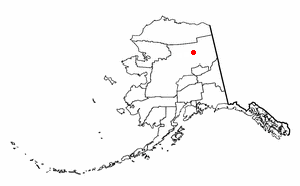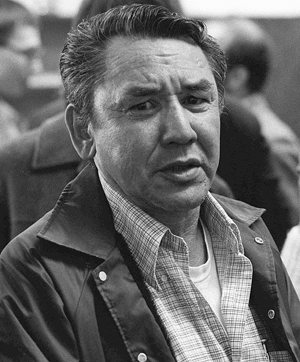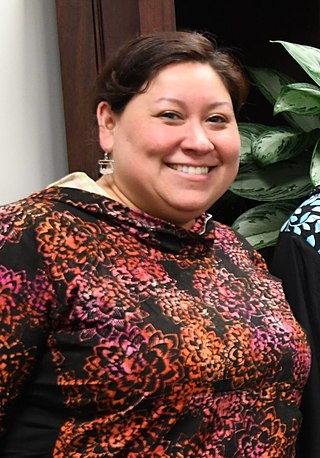
The Yukon River is a major watercourse of northwestern North America. From its source in British Columbia, it flows through Canada's territory of Yukon. The lower half of the river continues westward through the U.S. state of Alaska. The river is 3,190 kilometres (1,980 mi) long and empties into the Bering Sea at the Yukon–Kuskokwim Delta. The average flow is 6,400–7,000 m3/s (230,000–250,000 cu ft/s). The total drainage area is 854,700 km2 (330,000 sq mi), of which 323,800 km2 (125,000 sq mi) lies in Canada. The total area is more than 25% larger than Texas or Alberta.

Arctic Village is an unincorporated Native American village and a census-designated place (CDP) in Yukon-Koyukuk Census Area, Alaska, United States. As of the 2010 census, the population of the CDP was 152. This was unchanged from 2000. The village is located in the large Gwitch'in speaking region of Alaska, and the local dialect is known as Di'haii Gwich’in or shahanh. As of 1999, over 95% of the community speaks and understands the language. As of 2019, the second village chief was against oil drilling because of the impact on caribou.

Fort Yukon is a city in the Yukon-Koyukuk Census Area in the U.S. state of Alaska, straddling the Arctic Circle. The population, predominantly Gwich'in Alaska Natives, was 428 at the 2020 census, down from 595 in 2000.

Venetie, is a census-designated place (CDP) in Yukon–Koyukuk Census Area, Alaska. At the 2010 census, the population was 166, down from 202 in 2000. It includes the Village of Venetie, a Gwich'in tribal entity designated in the 1971 Alaska Native Claims Settlement Act.

The Gwichʼin language belongs to the Athabaskan language family and is spoken by the Gwich'in First Nation (Canada) / Alaska Native People. It is also known in older or dialect-specific publications as Kutchin, Takudh, Tukudh, or Loucheux. Gwich'in is spoken primarily in the towns of Inuvik, Aklavik, Fort McPherson, and Tsiigehtchic, all in the Northwest Territories and Old Crow in Yukon of Canada. In Alaska of the United States, Gwichʼin is spoken in Beaver, Circle, Fort Yukon, Chalkyitsik, Birch Creek, Arctic Village, Eagle, and Venetie.

The Dene people are an Indigenous group of First Nations who inhabit the northern boreal, subarctic and Arctic regions of Canada. The Dene speak Northern Athabaskan languages and it is the common Athabaskan word for "people". The term "Dene" has two uses:

The Gwichʼin are an Athabaskan-speaking First Nations people of Canada and an Alaska Native people. They live in the northwestern part of North America, mostly north of the Arctic Circle.
Koyukon is the geographically most widespread Athabascan language spoken in Alaska. The Athabaskan language is spoken along the Koyukuk and the middle Yukon Rivers in western interior Alaska. In 2007, the language had approximately 300 speakers, who were generally older adults and bilingual in English. The total Koyukon ethnic population was 2,300.

Chief David Salmon was an Indigenous Alaskan that served as Chief of Chalkyitsik and later First Traditional Chief for the Gwich'in people. He was known for his commitment to improving his community and working for the people. Salmon would use his position and influence as chief to begin many public works and create programs dedicated to helping the Gwich'in people. As an advocate for education, Salmon would spread his knowledge by creating traditional Athabascan items for display or teaching his community to keep Athabascan traditions alive. At the same time, Chief Salmon would be trained and become the first Episcopal priest for Interior Alaska and spend a lot of his life spreading his faith.
Sarah Agnes James is a Neets'aii Gwich'in activist from Arctic Village, Alaska, USA, but was born in Fort Yukon "because that is where the hospital was. I grew up part of the time in Fort Yukon and Salmon River, but most of the time in Arctic Village, Alaska."James is a board member of the International Indian Treaty Council. She was awarded the Goldman Environmental Prize in 2002, together with Jonathon Solomon and Norma Kassi. They received the prize for their efforts to protect the Arctic National Wildlife Refuge (ANWR) from plans of oil exploration and drilling. Oil and gas exploration would disturb the life cycle of the Porcupine caribou, which has been a foundation for the Gwich'in culture since approximately 18,000 BC.

Jonathon Solomon was a native Gwich'in from Fort Yukon, Alaska, USA, and a member of the U.S. delegation to the International Porcupine Caribou Agreement between Canada and U.S. He served as the Traditional Chief of the Gwichyaa Zhee Gwich'in, a lifetime designation, from 2002 until his death in 2006. He was a founding member of the Gwich'in Steering Committee formed by the Gwich'in at Arctic Village in 1988, and dedicated to the preservation of the Porcupine Caribou Herd. He served with distinction until his death.
The Yukon River Inter-Tribal Watershed Council (YRITWC) is a multi-government advisory, advocacy, monitoring, and lobby group for protecting and cleaning up the Yukon River. It consists of 66 First Nations and tribes in Alaska, Yukon, and British Columbia, living along the Yukon River.
The Arctic Council Indigenous Peoples’ Secretariat (IPS) is a secretariat for the six international Indigenous organizations affiliated with the eight-nation Arctic Council. The IPS does not represent indigenous peoples or their organizations, but assists those organizations in presenting their causes, and helps to disseminate information among them. IPS was established in 1994 under the auspices of the Arctic Environmental Protection Strategy (AEPS). It was around the same time that the category of Permanent Participants was being developed and applied to the three indigenous peoples’ organizations then observers in the AEPS. When the Arctic Council was established in 1996, both the Permanent Participants and IPS was reinserted into the new intergovernmental framework. Since commencing business in 1994, the role of the secretariat has been to facilitate contributions from the Permanent Participants to the cooperation of the eight Arctic states and to assist the Permanent Participants in performing, mainly communicational task.

The Alaskan Athabascans, Alaskan Athapascans or Dena are Alaska Native peoples of the Athabaskan-speaking ethnolinguistic group. They are the original inhabitants of the interior of Alaska.

The United States public policy agenda on issues affecting Native Americans under the Obama administration includes the signing of the Tribal Law and Order Act of 2010, which allowed tribal courts to extend and expand sentences handed down to them in criminal cases, strengthening tribal autonomy. Obama also supported and enforced the Executive Order 13175, which requires the federal government to consult with tribal governments when deliberating over policies and programs that would affect tribal communities. Under the Obama Administration was also the launching of Michelle Obama's program Let's Move In Indian Country, which aims to improve opportunities for physical activity, to increase access to healthy food in tribal communities, and to create collaborations between private and public sectors to build programs that will end childhood obesity in Native communities. Obama also supported tribal communities through certain provisions of the American Recovery and Reinvestment Act of 2009, which allocated $510 million for rehabilitation of Native American housing, and the settlement of the Keepseagle case, a lawsuit against the United States Department of Agriculture for discriminating against tribal communities by not allowing them equal access to the USDA Farm Loan Program. Most recently, Obama signed Executive Order 13592, which seeks to improve educational opportunities for American Indian and Alaska Natives. Obama has been praised by many tribal leaders, including those who claim he has done more for Native Americans than all of his predecessors combined.

Pearl Kiyawn Nageak Brower is an American academic administrator. She was president of Iḷisaġvik College from 2012-2020.
The Aklavik First Nation is a Gwich'in First Nations band government in the Northwest Territories. The band is located in Aklavik, a mixed community of First Nations, Inuit, and non-Indigenous people.
Patricia 'Patsy' L. Whitefoot is a member of Yakama Nation, is Indigenous elder, activist and professional educator along with being the traditional food gatherer for the Toppenish Creek Longhouse. She served as the President of the National Indian Education Association and President Obama appointed her as a member of the National Advisory Council on Indian Education. She is a prominent advocate for Missing and Murdered Indigenous Women, and Indigenous rights.
Roberta "Bobbie" Conner, also known as Sísaawipam, is a tribal historian, activist, and indigenous leader who traces her ancestry to the Umatilla, Cayuse, and Nez Perce tribes. Conner is known for her work as the Director of the Tamástslikt Cultural Institute in Pendleton, Oregon, which seeks to protect, preserve, and promote the culture of the Umatilla, Cayuse, and Walla Walla peoples. In her role at the Tamástslikt Cultural Institute Conner has worked to educate the public on and preserve Indigenous culture through the "We Are," "We Were," and "We Will Be" series of exhibits, and has mentored young scholars interested in tribal cultural preservation. Conner has also sought to educate the public and fight for Native American rights in her personal life as an activist, with a special emphasis on the impact of the division into Tribal Nations and segregation into boarding schools on indigenous cultures, tribal land rights, sustainability, and the repatriation of human remains and funerary objects to Native American lands.
Frances Kay Wallis is an American traditional healer and former politician. She is a tribal doctor with the Southcentral Foundation. Wallis was a Democratic member of the Alaska House of Representatives from the 24th district from 1985 to 1990.









